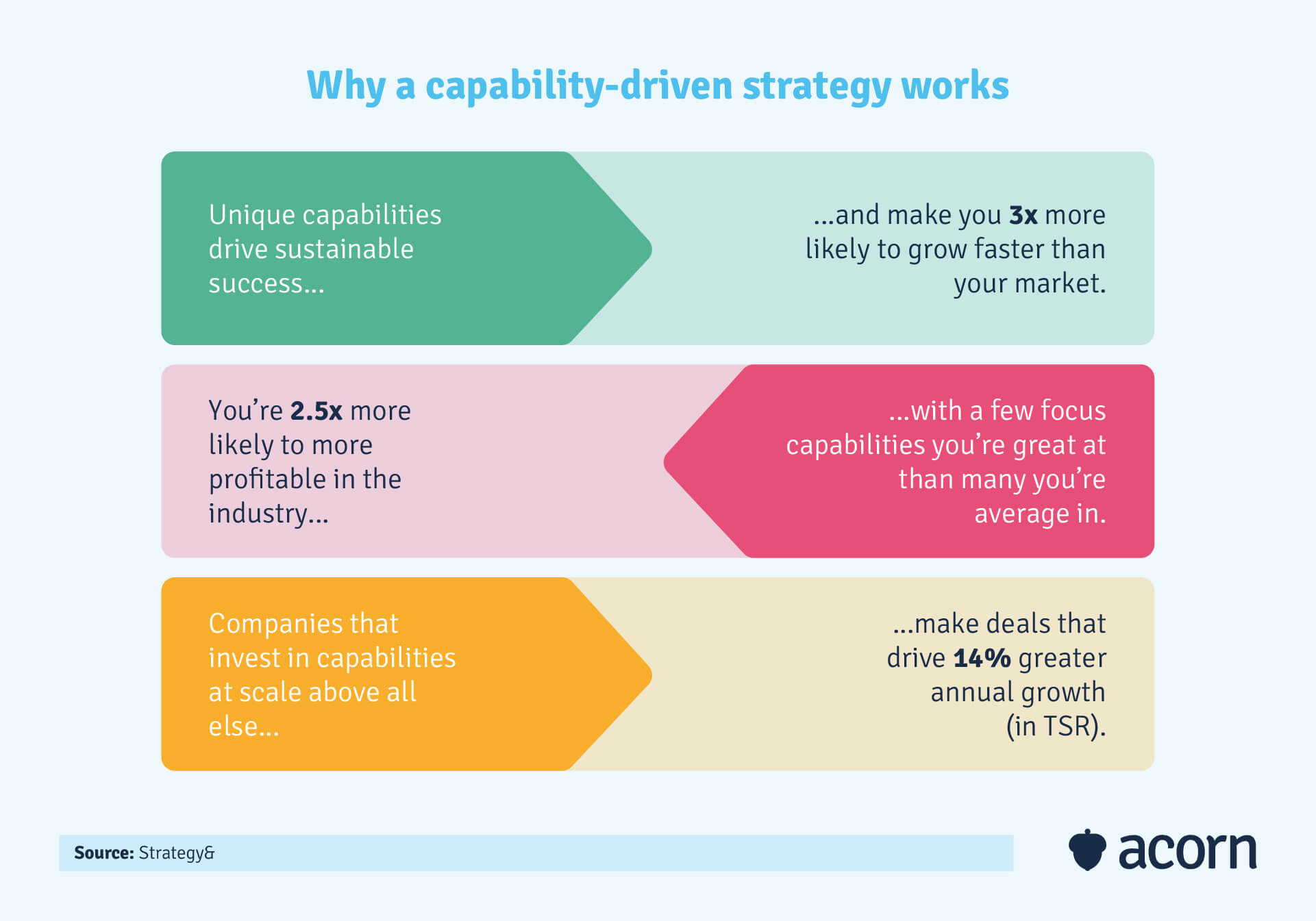Skill vs Capability vs Competency: How to Differentiate the Three
Reading Time:

Lead the pack with the latest in strategic L&D every month— straight to your inbox.
SubscribeSkill, capability and competency are all important and essential characteristics of an efficient workforce.
We’ve already gone two rounds in the “capability vs” debate, with two other blogs differentiating capability from skill and capability from competency. For the final round, we’re bringing all three back in the ring.
Each has their place in business planning activities. In fact, they are rather codependent in that skills are one part of organisational capabilities while competencies are used to assess both. But their impact on your bottom line varies wildly, which is why it’s important to know the distinction.
In this final blog of the series, we’ll walk you through the differences between skill, capability and competency and how they’re used in the workplace.
What is a skill?
A skill is a learned ability, talent or expertise needed to perform a task, usually to an industry standard or without supervision. Generally speaking, you can be technically skilled for a job role or possess soft skills that impact your relationships.
Skill vs ability
Ability refers to being able to do something typically innate like verbal communication. On the other hand, skill generally refers to abilities we learn to perform at a certain standard, like leadership skills.
What is a competency?
Competency assesses the application of a person’s knowledge and skills in the workplace. It is often used in performance reviews to evaluate an employee’s expertise in certain organisational capabilities.
What is a capability?
A capability is a combination of personal and technical skills, knowledge, processes, tools and behaviours that are critical to an organisation’s success and future needs. When used as part of strategic planning, human resources and professional development, capabilities drive business outcomes.
Skill, capability and competency: What makes them different?
It’s easy to use these terms as synonyms for one another without thinking, which is why we ask you to shift your mindset here. The key difference between skills, capabilities and competency is in the impacts that each has on business.
Example of skills
For clarity, let’s look at some real-life skills. Technical skills include:
- Data analysis
- Graphic design
- Coding.
While personal skills, or soft skills, can be:
- Time management
- Critical thinking
- Determination.
How skills are used in business
While collective skill is considered when scanning the workforce, skills are not a business metric. Problem solving or being able to effectively communicate won’t move the needle on their own.
Think of skills and abilities as a baseline. They’re used for role-related things like skill statements and job descriptions, so employers can assess if a person has the underlying abilities for a role. Skills gaps are also used to shape professional development, though they’re not the assessment tool we’d recommend (but more on that later).
An example of competency
We’re talking about performance evaluation. Remember marking rubrics or grades from school? Competencies are similar, though A+ and Distinction are two terms you’re unlikely to come across in business.
Instead, we often see wording like:
- Foundational
- Intermediate
- Adept/proficient
- Advanced
- Highly advanced/strategic.
How competencies are used in business
While different skills and capabilities can often be considered on their own, competence only exists to measure skills or capabilities.
For this reason, competencies really differ from skills or capabilities in that they are exhaustive. They often don’t eclipse five in total when used in business tools like a capability framework. This is because there is usually a fixed scale of performance within which employees are expected to work.
An example of capability
Now is when we start to really start to glean business impacts. An inherent quality of capabilities is that they describe a tangible outcome. The name has to tell you what it’s achieving.
How capabilities are used in business
Legacy learning solutions focus on two things: Skills taxonomies and massive content libraries. The problem is that neither of those align with business on their own, and combined, they simply overwhelm the people they’re meant to help.
This is why we pioneered the performance learning management system (PLMS). It uses capabilities as a base for learning—all content is mapped to capabilities to provide the most relevant and impactful learning experience. That provides a factual basis on which to measure performance improvements, and thereby prove the impact of learning on business outcomes.
We’ll dive deep into the real business importance of capabilities in just a few paragraphs, so bear with us.
Which is more important in the workplace?
Competency, skills and capabilities all play their part in the workplace, to varying degrees of impact. It’s just that different people use them for different tasks.
Why skills are important in the workplace
Skills perhaps matter most to the hiring process, specific training initiatives and workplace culture, and are usually bucketed into technical and soft skillsets.
Technical skills
So named as these are skills that are teachable and quantifiable. You’d explain how you’ve developed and used them in a job interview, and the hiring manager would assess that against the abilities needed in a specific job.
They matter because there will be a technical set of skills required for every role. However, hard skills (as they’re otherwise known) usually only describe a person’s current state, meaning they’re not the most valuable tool to rely on in the workplace.
Soft skills
In layman’s terms, soft skills are behaviours, traits and habits. If you’re not already, you should be training for soft skills as much as technical skills.
92% of recruiters say soft skills are equally or more important than hard skills. 40% of jobseekers say colleagues and culture is a top priority when accepting a role. Bad hires typically lack soft skills more than technical abilities. Need we say more?
There’ll be a complex mix of personal abilities like intercultural understanding, conflict resolution, teamwork, ethical understanding, emotional intelligence and self-motivation that you want in leaders. But they may not come easily to budding leaders who are taking on emotional labour for the first time, let alone integrating knowledge of strategy into employees’ day to day (a crucial task).
Keep listing, developing and maintaining certain behaviours and traits, as this is important for maintaining a culture you’re proud of and people want to work for.
Still, skills are only the tip of the performance iceberg.
Why competence is important in the workplace
Many big institutions refer to core competency in the same way we’d talk about core capabilities. It’s a bit off course from our understanding and the way industry leaders like Josh Bersin look at organisational differentiators.
That being said, competency models are still important as they assess the expertise of an employee’s skills application against your standards for performance. That’s useful for:
- Internally benchmarking performance for both capabilities and job roles
- Setting timely learning and development interventions
- Giving employees autonomy in their career
- Encouraging and establishing a practice of lifelong learning.
But perhaps the most important part of competency is that it creates a universal set of expectations. Clear communication on expectations means that progress can effectively be monitored by L&D leaders and employees can accurately self-assess their abilities.
Plus, when you have an aggregate view of competence, L&D metrics are easier to ascertain. That’s because training initiatives that solve or reduce long-term business issues (like lacking performance, which affects everything from productivity to time to market) are much easier to sell to executives—solidifying L&D as a profit centre.
However, you still need to know what you’re assessing before you can determine just how well you’re doing it.
Why capabilities are important in the workplace
While they can be used to assess human abilities at a granular view, capabilities also look high level to shape business transformation. Consider:
- Technology changes the job landscape at a faster rate than ever. Most new skills expire within five years of learning them. 50% of employees will need to be reskilled by 2025.
- How leadership impacts strategy. Do you have a talent pipeline in place? Do your current leaders effectively influence and inspire? How quickly can you fill a role if a leader leaves? How do you even define “great leadership”?
- The job market flips quickly between an employer and candidate home court advantage. You could be short on people for crucial job roles before you know it, if you rely on regular and/or external recruitment.
- Your desired future state. How do you plan to get there, if you don’t have the roles, people, processes or knowledge already in place?
Capabilities are inherently stable. What you define as a core capability now will reasonably be a key driver for your organisation in future, even if your business goals change. If it sounds strange not to change your business tools, remember that boring as a strategy saves you from alienating existing customers with too much innovation (by keeping promises and being predictable).
Small, consistent innovations also mean you don’t fall behind competitors and allow you to still make big moves—with less risk since you’re not trying to close a massive gap or chase a competitor’s success. And if you’re still not convinced, keep in mind that Warren Buffet, whose business acumen is considered some of the shrewdest in world, built his success on “safe” investment choices.
Capabilities are also not easily replicable in other organisations, unlike skills and measures of competence. You and a competitor may both rely on project management skills, but it’ll be how you combine that with mission-critical knowledge, internal tools and processes, and cultural behaviours that makes the difference.

When compiled in a framework, you’ve got:
- Architecture to weather environmental changes
- An argument for strategic change
- Clearly defined differentiators for both executives and employees
- A sustainable and replicable reference for scaling success.
Key takeaways
The difference between capabilities, skills and competency is simpler than the web of available information would have you think.
Skills are your starting point. They shape job descriptions, training opportunities and recruitment. Competency is a measure of performance, whether that’s of a skill or capability.
Capabilities combine your skills, knowledge, tools, processes, behaviours and competencies. They can be as nuanced as shaping individual training plans or large scale enough to architect business transformation. And while skills and competency wax and wane, capabilities remain stable, giving you a sustainable framework for future business success.